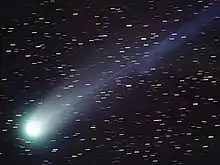206P/Barnard–Boattini
206P/Barnard–Boattini was the first comet to be discovered by photographic means.[6] The American astronomer Edward Emerson Barnard did so on the night of October 13, 1892.
| Discovery | |
|---|---|
| Discovery date | October 13, 1892 |
| Designations | |
| Barnard 3; D/1892 T1; P/1892 T1; 1892e; 1892 V; P/2008 T3 | |
| Orbital characteristics | |
| Epoch | 2000-Mar-03.00 (JD 2451606.5)[1] |
| Aphelion | 5.30856 AU |
| Perihelion | 0.97881 AU |
| Semi-major axis | 3.143688 AU |
| Eccentricity | 0.688642 |
| Orbital period | 5.5740 a |
| Inclination | 31.9741° |
| Last perihelion | March 4, 2021[2] August 27, 2014[3][4] October 25, 2008 |
| Next perihelion | 2027-Sep-13[5] |
| Earth MOID | 0.018 AU (2,700,000 km)[1] |
After this apparition this comet was lost and was thus designated D/1892 T1.
Ľuboš Neslušan (Astronomical Institute of the Slovak Academy of Sciences) suggests that 14P/Wolf and this comet are siblings which stem from a common parent comet.[7]
This comet was rediscovered on October 7, 2008 by Andrea Boattini in the course of the Mt. Lemmon Survey. It was initially credited to Boattini before it was identified as Comet Barnard 3.[6] The comet passed 0.1904 AU (28,480,000 km; 17,700,000 mi) from Earth on October 21, 2008.[1] The comet has made 20 revolutions since 1892 and passed within 0.3–0.4 AU of Jupiter in 1922, 1934 and 2005.[8][9]
It was not seen during the 2014 perihelion passage because when the faint comet was at the brightest of about magnitude 20 it was only 75 degrees from the Sun. It has not been seen since January 2009.[2] The comet passed 0.1303 AU (19,490,000 km; 12,110,000 mi) from Jupiter on July 9, 2017.[1]
It came to perihelion in 2021, but was not observed because it was close to the Sun in the sky and was not expected to get brighter than about apparent magnitude 23. It will next come to perihelion in September 2027.[5]
The comet has an Earth-MOID of 0.018 AU (2,700,000 km; 1,700,000 mi).[1]
References
- "JPL Small-Body Database Browser: 206P/Barnard-Boattini" (last observation: 2009-01-04). Jet Propulsion Laboratory. Retrieved 2016-01-10.
- "206P/Barnard-Boattini Orbit". Minor Planet Center. Retrieved 2016-01-10.
- Syuichi Nakano (2009-03-18). "206P/Barnard-Boattini (NK 1752)". OAA Computing and Minor Planet Sections. Retrieved 2012-02-25.
- 206P/Barnard-Boattini at Kazuo Kinoshita's home page
- "Horizons Batch for 206P/Barnard-Boattini on 2027-Sep-13" (Perihelion occurs when rdot flips from negative to positive). JPL Horizons. Retrieved 2021-09-13. (JPL#13/Soln.date: 2021-Apr-15)
- 206P at Garry Kronk’s Cometography Archived September 25, 2010, at the Wayback Machine
- Ľuboš Neslušan, Comets 14P/Wolf and D/1892 T1 as parent bodies of a common, alpha-Capricornids related, meteor stream Astronomy and Astrophysics, vol. 351, pp. 752–758 (1999) PDF Archived 2008-10-31 at the Wayback Machine
- IAUC 8995 Archived July 19, 2011, at the Wayback Machine
- The COCD Homepage: News – October 2008
External links
- Orbital simulation from JPL (Java) / Horizons Ephemeris
- 206P/Barnard-Boattini – Seiichi Yoshida @ aerith.net

.png.webp)